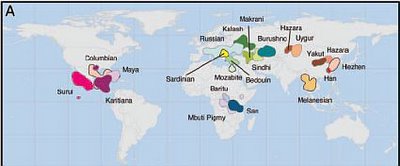 Examples of 50%-confidence kernels for population placement based on population average allele frequencies. Populations are: Columbian, Hezhen, Kalash, Karitiana, Lahu, Makrani, Mandega, Maya, Mbuti Pigmy, Melanesian, Mozabite, New Guinea, Orcadian, Palestinian, Pima, Russian, Sardinian, Uygur, Yakut, Yizu, and San. In most cases, a single kernel results, although, in populations Hezhen, Karitiana, and Pima, the kernel has broken into two or three regions.
Examples of 50%-confidence kernels for population placement based on population average allele frequencies. Populations are: Columbian, Hezhen, Kalash, Karitiana, Lahu, Makrani, Mandega, Maya, Mbuti Pigmy, Melanesian, Mozabite, New Guinea, Orcadian, Palestinian, Pima, Russian, Sardinian, Uygur, Yakut, Yizu, and San. In most cases, a single kernel results, although, in populations Hezhen, Karitiana, and Pima, the kernel has broken into two or three regions.Proc. Natl. Acad. Sci. USA, 10.1073/pnas.0507991103
Global genetic positioning: Evidence for early human population centers in coastal habitats
William Amos and Andrea Manica
For an alternative perspective on relationships among human populations, we combined genetic and geographic information, using allele frequency gradients to place populations and individuals on the globe. Reanalyzing published data on 51 worldwide populations [Rosenberg, N. A., Pritchard, J. K., Weber, J. L., Cann, H. M., Kidd, K. K., Zhivitovsky, L. A. & Feldman, M. W. (2002) Science 298, 2381-2385] reveals five geographic clusters lying in plausible sites either of early agricultural innovation or on ancient migration routes. Also, the inferred sites show significant association with coastlines, suggesting that most early humans lived near large bodies of water. Our approach is flexible, and developments should prove useful both for exploring historical demography and for the identification of likely origin for unknown forensic samples.
Link

No comments:
Post a Comment